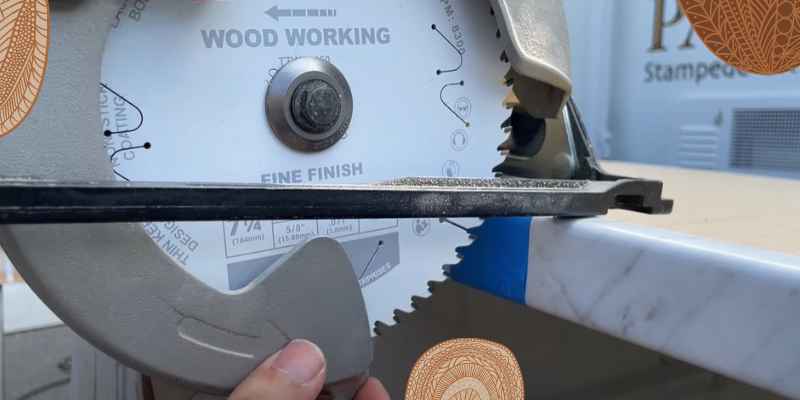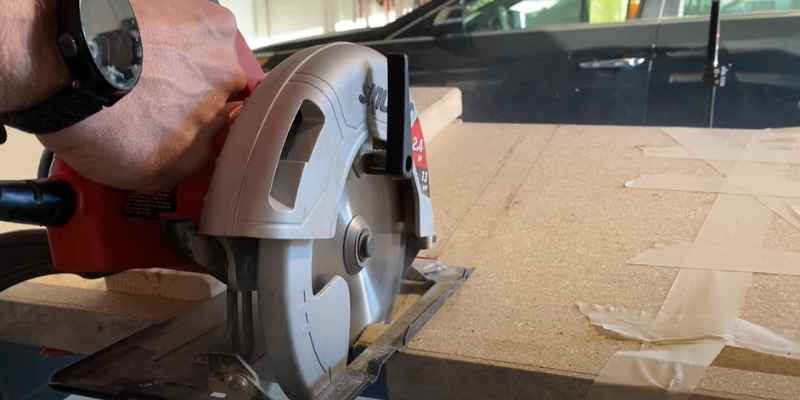A few different circular saw blades can be used to cut laminate countertops. The most common type is the carbide-tipped Blade, explicitly designed for cutting laminate. These blades are available in various sizes and can be found at most hardware stores.
Another option is to use a diamond-tipped blade, which will provide a clean cut and can be used on any laminate. However, these blades are more expensive and may not be necessary if you only cut a small amount of countertop. Finally, you can also use a regular wood-cutting knife, but it’s essential to ensure that the teeth are sharpened, so they don’t tear the laminate.
Cutting Laminate Countertop With A Jigsaw | Which Blade Should I Be Using? | HANDYMAN HEADQUARTERS |
If you’re installing a laminate countertop, you’ll need to choose the right type of circular saw blade. Here are a few things to keep in mind when making your selection:
1. The thickness of the Blade will determine how deep of a cut you can make.
For most laminate countertops, a thin blade is all you need.
2. The number of teeth on the Blade also matters. A higher number of teeth results in a smoother cut, while fewer teeth will give you a faster amount.
3. Choose a carbide-tipped blade for the best durability and cutting performance. With these factors in mind, select the appropriate circular saw blade for your laminate countertop project and enjoy professional results!

Best 7 1/4 Circular Saw Blade for Laminate Countertop
There are a lot of different factors to consider when trying to find the best 7 1/4 circular saw blade for a laminate countertop. The most important thing is probably the type of wood that you’re using. If you’re using a softwood like pine, you’ll want a blade with more teeth so it can cut through the material more easily.
If you’re using hardwood like oak, you’ll want a blade with fewer teeth so it doesn’t get bogged down in the material. Another critical factor is the thickness of the laminate. If you have thick laminate, you’ll need a different blade than a thin laminate.
The thicker the laminate, the more powerful the saw must be to cut through without damaging the surface. Finally, it would be best to consider what finish you want on your countertop. If you want a smooth finish, you’ll need to get a different blade than if you’re looking for a rougher finish.
Smooth finishes require blades with fewer teeth so that they don’t leave any scratches or gouges behind. Rougher finishes can be achieved with blades with more teeth, but they will also likely leave behind some damage to the surface of your countertop.
What Type of Blade to Cut the Formica Countertop
When it comes to cutting Formica countertops, there are a few different blade options that you can choose from. Each type of Blade has its benefits and drawbacks, so selecting the right one for your project is essential. One option is to use a circular saw with a carbide-tipped blade.
This type of Blade is designed specifically for cutting the laminate to produce clean, precise cuts. However, controlling a circular saw can be difficult, so this option is best suited for experienced DIYers. Another option is to use an oscillating tool with a plunge-cut blade.
This tool is much easier to control than a circular saw, making it ideal for beginners. Plus, the plunge cut blade will help you make clean, accurate cuts. Finally, you could also use a jigsaw with a fine-tooth blade.
This option is excellent for making curved or intricate cuts on your Formica countertop. Remember that jigsaws can be tricky to maneuver, so they’re not always the best choice for beginners. No matter which type of Blade you choose, be sure to follow all safety precautions when cutting Formica countertops.
And if you’re ever unsure about which tool or technique to use, always consult an experienced professional before beginning your project.
165Mm Circular Saw Blade for Laminate
When choosing the right circular saw blade for your laminate floors, there are a few things you need to consider. The most crucial factor is the diameter of the Blade. Most laminate flooring is cut with a 165mm circular saw Blade.
Next, you need to consider the number of teeth on the Blade. You want a blade with at least 40 teeth, but more is better. The more teeth on the Blade, the smoother the cut will be.
Finally, it would be best if you made sure that the Blade has been designed specifically for cutting laminate flooring. Some blades are made for general-purpose use and others for cutting laminate. Be sure to get an edge that says it is designed for cutting laminate floors.
With these three factors in mind, you should have no problem finding the perfect circular saw blade for your laminate floors.
Best Type of Jigsaw Blade to Cut Laminate Countertop
A few different jigsaw blades can be used to cut laminate countertops, but not all are created equal. The best kind of blade type for this job is a carbide-tipped blade. These blades are made from a tough and durable material that can handle the tough cuts required to get through the laminate.
They also tend to stay sharper for longer, so you won’t have to replace them as often. Another option is a bi-metal blade, which is also quite durable and can handle the tough cuts required for laminate. However, these blades don’t last as long as carbide-tipped blades and will need to be replaced more often.
A high-speed steel (HSS) blade will work just fine if you’re looking for an economical option. These blades aren’t as durable as the other two options, but they’re much less expensive and will still get the job done. Just keep in mind that you’ll need to replace them more frequently.
6 1/2 Circular Saw Blade for Laminate
If you’re looking for a circular saw blade that can handle laminate, you’ll need to find one specifically designed for the material. Laminate is a rigid material; regular blades just won’t cut it. It would be best if you had a knife with sharp teeth to handle the pressure.
The best way to find a good laminate blade is to ask around at your local home improvement store. The experts there will be able to point you in the right direction once you’ve found a few options; research online to see what other customers say about them.
Once you’ve found the perfect Blade, all that’s left is to get cutting! With the right tool, laminate is no match for your circular saw.
What is the Best Circular Saw Blade for Cutting Worktops?
The best circular saw Blade for cutting worktops will depend on the thickness and type of worktop you use. For thicker worktops, a more powerful circular saw with a more robust blade will be needed. A less powerful booklet saw with a finer blade will suffice if you work with a thinner or softer worktop material.
Be sure to consult your worktop manufacturer’s recommendations before making any cuts.

Can You Use Circular Saw on Laminate?
Using a circular saw is possible if you’re looking to do a quick and easy job of cutting laminate. However, there are a few things you need to keep in mind to avoid damaging the material. First, ensure that the Blade you’re using is designed to cut laminate.
This means that it should be sharp and have a fine tooth count. Otherwise, you risk chipping or breaking the laminate as you cut through it. Secondly, take your time when making cuts.
Laminate is much thinner and more fragile than other materials like wood, so rushing through the process will only increase your chances of making mistakes. Slow and steady wins the race here! Finally, use a straight-edge guide when cutting laminate with a circular saw.
This will help ensure that your cuts are clean and precise. And if you don’t have a straight edge guide handy, simply clamping down a piece of scrap wood onto the laminate will work just as well.
How Can I Cut My Countertop Without Chipping?
If you’re looking to cut your countertop without chipping, you can do a few things to make sure it comes out clean. First, use a sharp blade – dull blades are more likely to chip the material. Second, take your time and ensure each cut is straight – rushing through the process is more likely to result in an imperfection.
Finally, use a guide or template to help ensure that your cuts are precise. With these tips in mind, you should be able to achieve a clean, professional-looking finish on your next countertop project!
Can You Cut Laminate Worktop With a Circular Saw?
If you’re planning on installing a new laminate countertop in your kitchen, you might wonder if you can cut it with a circular saw. The answer is yes, but there are a few things you need to know first. Laminate is a durable and easy-to-care-for material that’s ideal for busy kitchens.
It comes in various colors and patterns to find the perfect look for your space. And, because it’s made from layers of plastic fused, it’s relatively easy to cut with power tools like a circular saw. That said, there are a few tips to keep in mind when cutting laminate:
1. Use a fine-toothed blade: A sharp, fine-toothed knife will give you the best results when cutting laminate. Avoid using a blunt or damaged edge, which can cause chipping or uneven cuts.
2. Score the surface first: Before making any cuts, score the surface of the laminate with a utility knife. This will help prevent chipping and ensure that your cuts are clean and precise.
3. Make gradual cuts: When using a power tool like a circular saw, take gradual cuts rather than trying to go through the entire piece simultaneously. This will help prevent damage to the laminate and give you more control over your cuts.
4. Use clamps: To avoid unintended movement while cutting, use clamps to secure the laminate before making any cuts. This will give you cleaner results and help prevent injury.
Conclusion
When cutting laminate countertops, you need to use the correct type of circular saw blade to get a clean, precise cut. Two main blades can be used: a standard wood-cutting blade and a laminate-specific blade. A standard wood-cutting blade can be used to cut laminate, but it will not give you as clean or precise of a cut as a laminate-specific blade.
Laminate-specific blades have teeth designed to cut through the rugged surface of laminate without chipping or breaking it. If you’re doing a lot of cutting on laminate countertops, investing in a good quality laminate-specific blade is worth the extra cost. However, using a standard wood-cutting blade will suffice if you only need to make occasional cuts.

